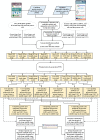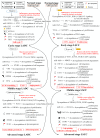Comparing progression molecular mechanisms between lung adenocarcinoma and lung squamous cell carcinoma based on genetic and epigenetic networks: big data mining and genome-wide systems identification
- PMID: 31217907
- PMCID: PMC6557199
- DOI: 10.18632/oncotarget.26940
Comparing progression molecular mechanisms between lung adenocarcinoma and lung squamous cell carcinoma based on genetic and epigenetic networks: big data mining and genome-wide systems identification
Abstract
Non-small-cell lung cancer (NSCLC) is the predominant type of lung cancer in the world. Lung adenocarcinoma (LADC) and lung squamous cell carcinoma (LSCC) are subtypes of NSCLC. We usually regard them as different disease due to their unique molecular characteristics, distinct cells of origin and dissimilar clinical response. However, the differences of genetic and epigenetic progression mechanism between LADC and LSCC are complicated to analyze. Therefore, we applied systems biology approaches and big databases mining to construct genetic and epigenetic networks (GENs) with next-generation sequencing data of LADC and LSCC. In order to obtain the real GENs, system identification and system order detection are conducted on gene regulatory networks (GRNs) and protein-protein interaction networks (PPINs) for each stage of LADC and LSCC. The core GENs were extracted via principal network projection (PNP). Based on the ranking of projection values, we got the core pathways in respect of KEGG pathway. Compared with the core pathways, we found significant differences between microenvironments, dysregulations of miRNAs, epigenetic modifications on certain signaling transduction proteins and target genes in each stage of LADC and LSCC. Finally, we proposed six genetic and epigenetic multiple-molecule drugs to target essential biomarkers in each progression stage of LADC and LSCC, respectively.
Keywords: NSCLC; genetic and epigenetic network; lung adenocarcinoma; lung squamous cell carcinoma; potential drug target.
Conflict of interest statement
CONFLICTS OF INTEREST The authors declare that there are no conflicts of interest regarding the publication of this paper.
Figures






Similar articles
-
Investigating the mechanism of hepatocellular carcinoma progression by constructing genetic and epigenetic networks using NGS data identification and big database mining method.Oncotarget. 2016 Nov 29;7(48):79453-79473. doi: 10.18632/oncotarget.13100. Oncotarget. 2016. PMID: 27821810 Free PMC article.
-
Systems Biology Approaches to Investigate Genetic and Epigenetic Molecular Progression Mechanisms for Identifying Gene Expression Signatures in Papillary Thyroid Cancer.Int J Mol Sci. 2019 May 23;20(10):2536. doi: 10.3390/ijms20102536. Int J Mol Sci. 2019. PMID: 31126066 Free PMC article.
-
Genome-scale meta-analysis of DNA methylation during progression of lung adenocarcinoma.Genet Mol Res. 2015 Aug 7;14(3):9200-14. doi: 10.4238/2015.August.7.30. Genet Mol Res. 2015. PMID: 26345853
-
Pre-clinical lung squamous cell carcinoma mouse models to identify novel biomarkers and therapeutic interventions.Front Oncol. 2023 Sep 25;13:1260411. doi: 10.3389/fonc.2023.1260411. eCollection 2023. Front Oncol. 2023. PMID: 37817767 Free PMC article. Review.
-
[Epigenetic regulations in laryngeal squamous cell carcinoma].Lin Chuang Er Bi Yan Hou Tou Jing Wai Ke Za Zhi. 2018 Nov;32(22):1958-1762. doi: 10.13201/j.issn.1001-1781.2018.22.019. Lin Chuang Er Bi Yan Hou Tou Jing Wai Ke Za Zhi. 2018. PMID: 30716813 Review. Chinese.
Cited by
-
Low frequency variants associated with leukocyte telomere length in the Singapore Chinese population.Commun Biol. 2021 May 3;4(1):519. doi: 10.1038/s42003-021-02056-7. Commun Biol. 2021. PMID: 33941849 Free PMC article.
-
Identifying Drug Targets of Oral Squamous Cell Carcinoma through a Systems Biology Method and Genome-Wide Microarray Data for Drug Discovery by Deep Learning and Drug Design Specifications.Int J Mol Sci. 2022 Sep 8;23(18):10409. doi: 10.3390/ijms231810409. Int J Mol Sci. 2022. PMID: 36142321 Free PMC article.
-
Noncoding RNAs and Liquid Biopsy in Lung Cancer: A Literature Review.Diagnostics (Basel). 2019 Dec 9;9(4):216. doi: 10.3390/diagnostics9040216. Diagnostics (Basel). 2019. PMID: 31818027 Free PMC article. Review.
-
Identification of candidate genes and prognostic value analysis in patients with PDL1-positive and PDL1-negative lung adenocarcinoma.PeerJ. 2020 Jun 17;8:e9362. doi: 10.7717/peerj.9362. eCollection 2020. PeerJ. 2020. PMID: 32607285 Free PMC article.
-
Computational identification of host genomic biomarkers highlighting their functions, pathways and regulators that influence SARS-CoV-2 infections and drug repurposing.Sci Rep. 2022 Mar 11;12(1):4279. doi: 10.1038/s41598-022-08073-8. Sci Rep. 2022. PMID: 35277538 Free PMC article.
References
-
- Ettinger DS, Akerley W, Borghaei H, Chang AC, Cheney RT, Chirieac LR, D’Amico TA, Demmy TL, Govindan R, Grannis FW Jr, Grant SC, Horn L, Jahan TM, et al. , and National comprehensive cancer network . Non-small cell lung cancer, version 2.2013. J Natl Compr Canc Netw. 2013; 11:645–53. 10.6004/jnccn.2013.0084. - DOI - PubMed
LinkOut - more resources
Full Text Sources
Miscellaneous

